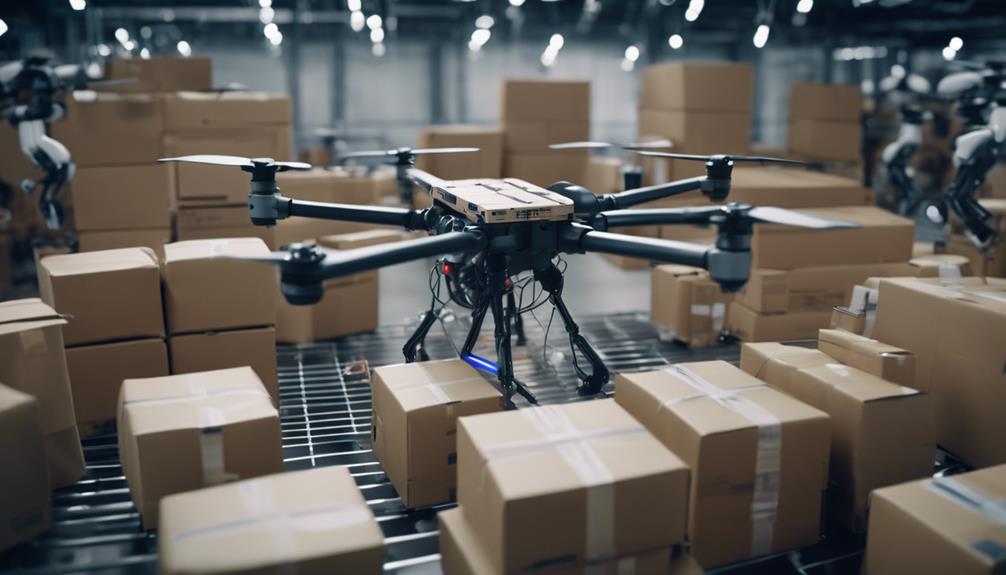AI gives businesses a competitive edge by optimizing workflows, enhancing productivity, and cutting costs. I've seen AI automate repetitive tasks, improving team efficiency with tools like Asana and Otter.ai. Predictive analytics refine strategic planning, ensuring we meet market demands accurately. AI-driven content generation scales marketing efforts, using data to craft SEO-friendly personalized messages. In supply chains, AI provides precise demand forecasting and superior inventory management. Real-time fraud detection and machine learning improve risk assessments and customer personalization, boosting satisfaction and loyalty. Explore how leveraging AI can transform your business operations and strategy for continued success.
Key Takeaways
- AI-driven automation enhances efficiency, reduces errors, and speeds up business processes.
- Predictive analytics provide accurate forecasts for sales trends and market demand, refining strategic planning.
- Personalized customer experiences increase satisfaction and loyalty through real-time behavior analysis.
- AI-powered content generation scales marketing efforts with SEO-friendly, personalized messaging.
- AI optimizes supply chain management, ensuring efficient procurement and reducing costs.
Workflow Automation
Workflow automation using AI greatly speeds up business processes and minimizes manual errors. By leveraging tools like Asana, ClickUp, and Zapier, I can integrate these capabilities into our communication software, creating a seamless workflow automation system.
This integration not only streamlines tasks but greatly boosts efficiency and productivity within product teams. AI-driven workflow automation enhances collaboration and fosters better communication among team members, driving strategic alignment.
The time savings achieved through these automation tools translate directly into cost savings, making our operations more efficient and financially sustainable. By adopting AI for workflow automation, I make sure that our business processes are optimized, allowing us to stay ahead in a competitive landscape.
Asynchronous Work
Harnessing AI tools for asynchronous work practices promotes effective collaboration and sustained productivity without the constraints of real-time communication. By integrating AI tools like Otter.ai and Notions AI, I can facilitate efficient collaboration through quick summaries and organized materials, reducing the need for traditional meetings.
Switchboard plays an important role in keeping teams organized and productive in an asynchronous setting. These AI tools don't just streamline tasks; they also boost productivity for product teams. Notions AI, for instance, enhances creativity, sparking new ideas and innovative solutions.
Content Generation

Leveraging AI tools like OpenAI for content generation allows us to automate the creation of articles, blogs, and social media posts, saving valuable time and resources.
By utilizing advanced AI algorithms, we can generate personalized messaging tailored to specific audiences, guaranteeing our content remains engaging and relevant.
Automated creation not only boosts productivity but also enables us to scale our marketing efforts efficiently. Moreover, AI-driven content generation produces SEO-friendly content that enhances online visibility and engagement.
The data-driven approach of AI ensures that our content isn't only high-quality but also strategically aligned with our business objectives.
Predictive Analytics
When I leverage predictive analytics with AI, I can accurately forecast future sales trends, optimize inventory management, and predict market demand.
These data-driven insights allow me to refine my strategic planning and make informed decisions that enhance operational efficiency.
Future Sales Trends
Predictive analytics with AI consistently allows businesses to accurately forecast future sales trends by analyzing historical data and market variables. By leveraging AI-powered models, I can anticipate customer demand, optimize inventory levels, and enhance production efficiency. These insights enable me to make data-driven decisions for crafting effective sales strategies and achieving revenue growth.
Here's a quick look at how AI impacts various aspects of sales forecasting:
| Aspect | Impact of AI Predictive Analytics |
|---|---|
| Customer Demand | Accurate anticipation |
| Inventory Levels | Optimization |
| Production Efficiency | Enhanced |
| Sales Strategies | Data-driven |
| Revenue Growth | Improved |
With predictive analytics, I reduce guesswork, stay ahead of market trends, minimize risks, and maximize sales opportunities.
Inventory Management Optimization
Building on the predictive power of AI in sales forecasting, I also harness these insights to optimize inventory management, ensuring that demand fluctuations are anticipated with precision.
AI-driven predictive analytics enables proactive problem-solving within the supply chain, enhancing inventory management efficiency.
By incorporating Digital Twins technology, I can simulate various scenarios, ensuring peak inventory levels and continuous process efficiency.
This data-driven approach allows for strategic decisions that not only reduce costs but also elevate customer satisfaction.
AI empowers me to make informed choices, minimizing stockouts and overstock situations.
Through these innovations, I achieve a streamlined supply chain, poised to meet customer demands swiftly and accurately, giving my business a significant competitive edge.
Market Demand Forecasting
AI-driven market demand forecasting empowers me with the precision tools needed to predict customer behavior and scale production efficiently. By leveraging predictive analytics, I can enhance forecasting accuracy and make data-driven decisions that optimize inventory management. This not only aids in understanding market trends but also guarantees that my business stays one step ahead of fluctuating customer demand.
Here's a quick view of the benefits:
| Benefit | Description | Impact |
|---|---|---|
| Forecasting Accuracy | Improved precision in predicting demand | Informed business strategies |
| Market Trends | Insights into changing market dynamics | Competitive edge |
| Customer Demand | Better understanding of customer behavior | Efficient production scaling |
| Inventory Management | Optimization based on accurate forecasts | Reduced holding costs |
| Competitive Edge | Staying ahead of competitors | Market leadership |
Supply Chain Optimization

Harnessing AI in supply chain optimization provides unmatched visibility and actionable insights across every link of the chain. AI optimizes supply chain operations by leveraging predictive analytics to accurately forecast demand, ensuring efficient procurement and inventory management. This reduces costs and eliminates inefficiencies.
Utilizing Digital Twins technology, AI enables advanced scenario planning and continuous process improvement. This technology replicates physical supply chain elements in a digital environment, allowing for proactive problem detection and resolution. AI-driven insights also facilitate better communication with supply chain partners, enhancing collaboration and agility.
Fraud Detection
When it comes to fraud detection, I've seen AI revolutionize real-time transaction monitoring and anomaly detection.
Machine learning algorithms can analyze vast datasets to spot irregularities that traditional methods might miss.
Real-time Transaction Monitoring
Real-time transaction monitoring leverages AI to instantly detect and flag suspicious activities, safeguarding businesses from financial losses and data breaches. By employing advanced AI algorithms, it can analyze transaction patterns in real-time to identify fraud detection with greater accuracy than traditional methods.
This proactive approach not only protects customer data but also enhances overall security measures.
Implementing AI-powered real-time transaction monitoring allows for a reduction of risks and prevention of financial losses by swiftly addressing any flagged suspicious activities. Businesses that adopt these technologies gain a significant competitive edge, as they can assure customers of their robust data protection strategies.
Ultimately, leveraging AI for real-time fraud detection is a strategic move that fortifies both financial integrity and customer trust.
Anomaly Detection Algorithms
Anomaly detection algorithms in AI empower businesses to pinpoint fraudulent activities with precision, leveraging machine learning to uncover unusual patterns that signify potential threats. By analyzing vast datasets in real-time, these algorithms offer a robust competitive edge.
They enhance security measures by identifying anomalies that traditional methods might miss, greatly reducing the risk of financial losses. In my business, AI-driven anomaly detection algorithms have become indispensable, enabling proactive risk management and asset protection.
With advanced machine learning models, we're not just reacting to fraud but anticipating it, ensuring our security protocols stay a step ahead. This strategic vision positions us to minimize disruptions and safeguard our financial interests effectively.
Predictive Risk Analysis
Leveraging AI for predictive risk analysis allows businesses to preemptively detect fraud by analyzing transactional data patterns and identifying vulnerabilities. By utilizing AI technology, I can identify potential risks and implement proactive fraud prevention strategies, gaining a competitive advantage.
Key benefits include:
- Real-time fraud detection: Instantly flags suspicious activities.
- Machine learning algorithms: Improve accuracy in risk assessments.
- Enhanced security measures: Strengthen defenses against fraud.
- Cost savings: Prevent financial losses from fraudulent transactions.
- Data-driven insights: Inform strategic decision-making.
Predictive risk analysis with AI not only boosts security measures but also positions businesses at the forefront of innovation. By integrating these advanced systems, I'm ensuring that my company remains resilient and competitive in an increasingly digital world.
Customer Personalization

AI empowers businesses to deliver highly personalized customer experiences by analyzing individual behaviors and preferences in real-time. By leveraging AI, businesses can craft personalized recommendations that resonate deeply with individual customers, leading to increased customer satisfaction and loyalty.
AI enables businesses to design targeted marketing campaigns that are tailored to the unique needs and preferences of their audience, resulting in higher engagement and improved conversion rates. Through data-driven insights, AI helps identify patterns and trends, allowing for more precise customer personalization.
This strategic use of AI not only enhances the customer experience but also provides a competitive edge, ensuring businesses remain ahead in a rapidly evolving market landscape.
Frequently Asked Questions
What Are the Competitive Advantages of Using AI in Business?
Using AI in business gives me predictive analytics, enhanced cybersecurity, and customer insights. It enables process automation, improves supply chain management, and demand forecasting. I can implement dynamic pricing and enhance fraud detection, driving innovation and strategic growth.
How Can AI Influence the Competitiveness in Service Companies?
AI revolutionizes service companies by enabling unparalleled customer personalization, predictive analytics, and service automation. It drives demand forecasting, enhanced efficiency, fraud detection, sentiment analysis, and dynamic pricing, making these companies unstoppable in today's competitive landscape.
How Do Businesses Benefit From Ai?
I benefit from AI by leveraging customer insights for personalized marketing, using predictive analytics for decision support, enhancing operational efficiency, and improving fraud detection. Additionally, AI optimizes my supply chain and talent management strategies, driving innovation.
How Are Organizations Using Machine Learning to Achieve a Competitive Edge?
I use machine learning for predictive analytics, demand forecasting, and churn prediction. I also leverage customer segmentation, sentiment analysis, and personalized marketing to boost engagement. Quality control and fraud detection guarantee operational efficiency, driving our competitive edge.
Conclusion
So, what gives businesses a competitive edge with AI?
Well, if you enjoy endless meetings and manual data entry, then by all means, ignore workflow automation.
If you think guessing is better than predictive analytics, go right ahead.
But for the rest of us who appreciate efficiency, precision, and staying ahead of the competition, leveraging AI for everything from supply chain optimization to fraud detection isn't just a smart move—it's the only move.
Let's embrace the future, shall we?





